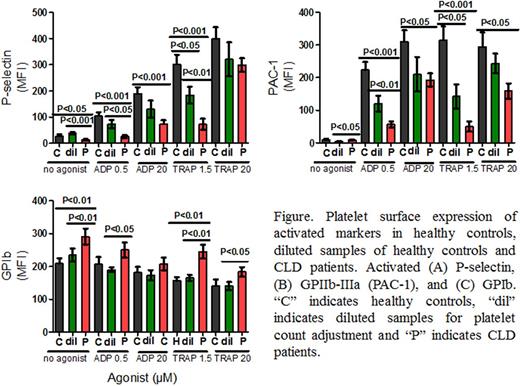Abstract
Background: Thrombocytopenia, the most common hematologic abnormality encountered in patients with chronic liver disease (CLD), results from multiple factors including splenic sequestration, relatively reduced production of thrombopoietin for the degree of thrombocytopenia, consumption of platelets secondary to autoantibodies directed against platelets, and bone marrow suppression. Elevated plasma levels of von Willebrand factor (VWF) in CLD patients may partly compensate for the reduced platelet count via interaction of VWF with the platelet receptors glycoprotein (GP) Ib-IX-V and GPIIb-IIIa (integrin αIIβ3), to promote platelet adhesion and aggregation following vessel injury. Platelets in patients with CLD are reported to have reduced function as measured by light transmission platelet aggregation (LTA) and other assays. However, LTA and most other platelet function tests are unreliable in thrombocytopenic samples. In contrast, platelet function evaluated by whole blood flow cytometry is accurate in samples with low platelet counts. Therefore, in the present study we used whole blood flow cytometry to determine whether platelet function as measured by platelet surface P-selectin, activated GPIIb-IIIa and GPIb on in vivo -circulating and in vitro -stimulated platelets is altered in thrombocytopenic CLD patients compared to healthy controls.
Methods: Platelet function end points were evaluated in untreated CLD patients with thrombocytopenia (n = 21) participating at U.S. sites in the Phase 3 E5501-G000-310 or E5501-G000-311 studies of a novel thrombopoietin receptor agonist, avatrombopag, compared to healthy controls (n=10). IRB approval was obtained at each study site and written informed consent was obtained from each subject. CLD patient samples analyzed in the present study were collected prior to the administration of any study drug. No patient received a platelet transfusion within 10 days of the blood draw for this study. Platelet surface P-selectin, activated GPIIb-IIIa and GPIb, without or with in vitro stimulation (0.5 μM adenosine diphosphate [ADP], 20 μM ADP, 1.5 μM thrombin receptor activating peptide [TRAP] or 20 μM TRAP) were measured by whole blood flow cytometry. To explore whether the differences in these markers between CLD patients and healthy subjects were related to the difference in platelet count rather than to differences in platelet activation or reactivity, whole blood from healthy controls was diluted with platelet-poor plasma to adjust the platelet counts to those of the thrombocytopenic CLD patients.
Results: Circulating platelets (i.e., no in vitro stimulation) from thrombocytopenic CLD patients showed low levels of platelet surface P-selectin and activated GPIIb-IIIa, similar to the healthy subject controls, demonstrating minimal in vivo platelet activation in thrombocytopenic CLD patients. However, the platelets of thrombocytopenic CLD patients had higher platelet surface GPIb mean fluorescence intensity (MFI) than either diluted or undiluted circulating platelets from healthy controls (Figure). In vitro stimulation of CLD patient platelets by ADP or TRAP resulted in lower levels of platelet surface P-selectin and activated GPIIb-IIIa compared to healthy controls, except for the levels of surface P-selectin after stimulation with 20 μM TRAP. The results for the diluted healthy subject controls were unaffected by the platelet count, except for the samples activated with 1.5 μM TRAP in which dilution resulted in reduced platelet surface P-selectin and activated GPIIb-IIIa.
Conclusions: 1) Circulating platelets in thrombocytopenic CLD patients are not activated. 2) Agonist-stimulated platelet surface expression of P-selectin and activated GPIIb-IIIa is reduced in thrombocytopenic CLD patients compared to healthy controls with the same degree of thrombocytopenia, which likely contributes to the excessive bleeding in thrombocytopenic CLD patients. 3) Thrombocytopenic CLD patients have a higher expression of GPIb on circulating platelets compared with healthy controls with the same degree of thrombocytopenia. This finding is consistent with the presence of an increased proportion of large immature platelets. The high levels of platelet surface GPIb, together with the previously reported high levels of circulating VWF in these patients, may contribute to vascular integrity at lower platelet counts.
Frelinger: Sysmex: Research Funding; Pfizer: Research Funding; Ironwood: Research Funding; Baxalta: Research Funding; GLSynthesis: Research Funding; Ionis: Research Funding. Michelson: GLSynthesis: Research Funding; Eisai: Research Funding; Ironwood: Research Funding; Sysmex: Research Funding; Ionis: Research Funding; Pfizer: Research Funding; AstraZeneca: Membership on an entity's Board of Directors or advisory committees; Elsevier: Patents & Royalties; Baxalta: Research Funding; Janssen: Membership on an entity's Board of Directors or advisory committees; Instrumentation Laboratory: Consultancy.
Author notes
Asterisk with author names denotes non-ASH members.


This feature is available to Subscribers Only
Sign In or Create an Account Close Modal